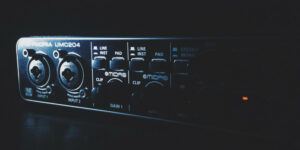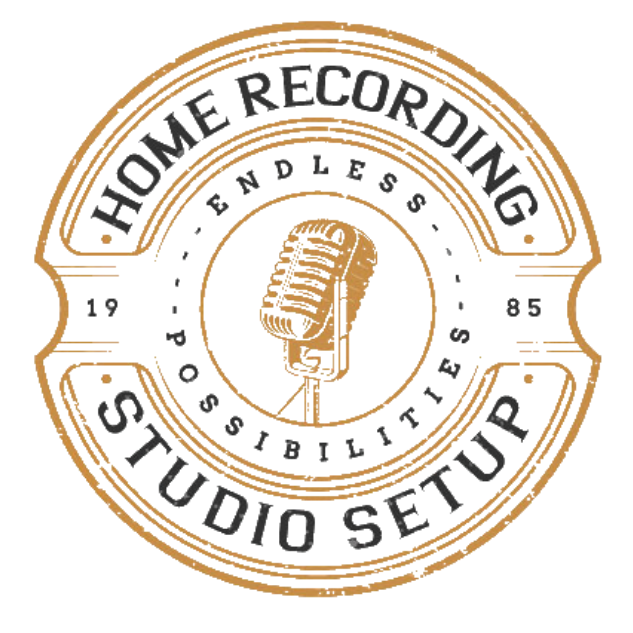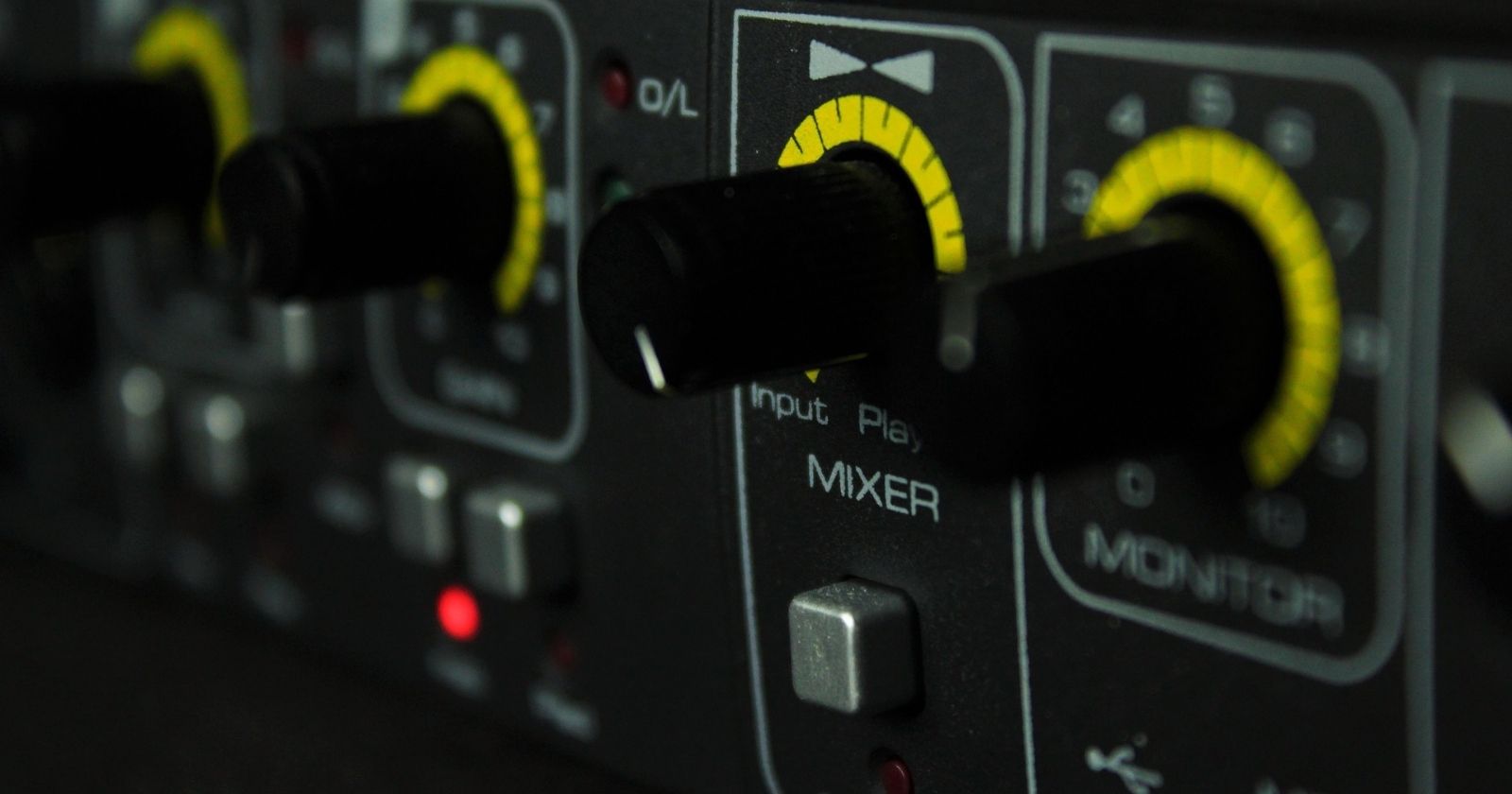
Setting up a home recording studio is a lot of fun. You get to pick out some cool gear and think about how it’s all going to be set up.
It’s fun to imagine how your studio will look in the room you have picked out and how to tie everything together.
One question I get a lot from readers is: What is a audio interface? So today let’s talk about audio interfaces. We will learn how they work and different options available.
Picking the right audio interface for your home recording studio is an important decision and I hope this article helps.
What Does A Audio Interface Do?
A audio interface is the medium from which you can plug your studio instruments and vocal microphones into to convert analog signal from the instruments and microphones into a digital signal the computer and DAW software uses.
When you play an instrument like a guitar, bass, vocals, or drums, the sound you hear is frequency or sound waves (analog).
When we record a particular instrument or vocal the goal is to get the instrument or vocal track into the computer’s DAW software.
Instruments and vocals are known as analog signal. The DAW software needs digital signal.
The audio interface converts the analog signal to digital to go into the DAW software. When you are working in your DAW software you need to be able to hear what you are doing. The computer sends the signal back out to your headphones or studio monitors through the audio interface.
The audio interface converts the digital signal back to analog and the analog sound waves are what you can hear coming out of your headphones or studio monitors.
So a audio interface first converts analog signal to digital signal. Then converts digital signal back to analog signal for playback.
Why Do I Need A Audio Interface?
Your desktop computer or laptop has built in speakers and a microphone but the sound quality is not going to be good enough for studio quality.
You need to be able to input your instruments and microphones into your computer with the best sound quality available.
This is where the audio interface shines. The converters in the audio interface need to be at least 24 bit /44.1kHz or higher. We talked about the audio interface converting analog to digital and then digital to analog.
Again, the main reason you need a audio interface is high quality converters and the ability to manipulate and control the audio signal.
What Kind Of Studio Are You Setting Up?
Will you be setting up a home studio for podcast, recording instruments and vocals (singer-songwriter style) , recording live bands with multiple instruments and vocals, or in the box mixing with VST instruments and creating beats?
It’s important to give some pre thought about how you will be using your home studio. What your goals or intentions are and how many instruments and microphones you will need to capture through your audio interface.
Take some time and give this some thought. It’s important to know this so you can choose a audio interface with enough inputs and outputs.
What Kind Of Audio Interface Do I Need?
I think the bare minimum you will need in a audio interface will be two XLR with 1/4″ combo microphone inputs. This way you have the ability to plug a guitar or bass into the interface or a microphone.
I highly recommend you get an audio interface with built in phantom power. Phantom power allows you to power a condenser microphone.
You will most definitely want to get a condenser microphone at some point. Don’t worry.. most audio interfaces come with phantom power built in as a standard.

If you are going to be using a midi keyboard you may want your audio interface to include midi in and midi out. You can also use a USB connection for your midi in and out functions.
Another thing to think about in a audio interface is the play back function. You will want the ability to use studio monitors for play back and a headphone jack. This way you can listen to your studio monitors or you can listen on your headphones.
Some people like to have the ability to be able to listen to more than one set of studio monitors. Often times they will have a regular set of studio monitors and a set of mono monitors so they can listen to the mix in mono.
If you plan on recording full bands then you will need the ability to have at least two or three headphone outputs for the different musicians in the band. Often times the whole band will not record at once. So having at least three headphone outputs will be a minimum place to start.
There are a lot of considerations to think about when choosing a good audio interface.
What Is The Best Audio Interface?
This will primarily depend on how you plan to use your home studio. You can spend a lot of money on a audio interface. Chances are you really don’t need to if you are just starting out.
Money spent on a audio interface is money well spent. Your audio interface will have a lot to do with the quality of your recordings so it’s OK to spend a little extra here.
Above we talked briefly about the audio interface converters. As a minimum I recommend 24bit resolution/ 44.1kHz. This describes the quality of the converters inside your audio interface.
If you want the best you want to be around 24 bit resolution/ 192kHz,
Many of the audio interface’s on the market allow you to choose your bit rate and kHz settings inside your DAW Software. If your computer can handle the load, then go for the higher settings.
Some more expensive audio interfaces have built in processors to help with processing the sound and this also takes the load off of your computer. This frees up processing for your DAW software and is a good option to consider.
Audio Interface Options VS Cost.
I think the best audio interface is the one that fits into your home studio budget. Money spent on an audio interface is money well spent. However, don’t blow your whole budget on the audio interface.
You can find excellent audio interface’s for around $150 dollars if you just want the ability to plug in two microphones with phantom power and 1/4 jack XLR combos, with midi in and out and the ability to listen to monitors or headphones.
You can also spend upwards of $4000 dollars for some audio interfaces with lots of inputs, outputs, and high quality converters.

Another thing to consider is what kind of inputs does your computer have. Audio interfaces run on USB, USB C, Thunderbolt, and FireWire. All of these interfaces will work well.
You may hear people talk about latency but often times latency can be corrected inside your DAW Software.
Thunderbolt and FireWire will be the quickest connections.
So the best audio interface will depend on how you plan on using your studio and how much you want to spend.
Again, money spent on an audio interface is money well spent. A lot of the audio interface’s will come with free entry level DAW software and plugins to help you get started.
We will talk more about different audio interfaces in upcoming articles.
Where Can I Get A Audio Interface?
Most online music store retailers have a good selection of audio interfaces.
I will add more on this later.
That’s A Wrap
I hope this article was helpful to you. No need to over think audio interfaces. All the confusing numbers about resolution and bit and kilo hertz can be daunting to some.
I laid out some basic formats to look for in your audio interface purchase. If you stick to the basic 24bit/ 44.1 kHz or higher then you will be in good shape.
If you are new to setting up your home recording studio I want to encourage you to get started. If you love playing, writing, mixing, and producing music then you are in the right place.
I try to bring you great gear and help you avoid gear that may be a waste of time and money.
If you have questions or comments leave them below. I’m always happy to help out.
Thanks,
Mitch
Mitch@homerecordingstudiosetup.com


An audio interface is an important piece of kit for a home recording studio. I can’t wait to get mine started, but will have to save up to get the cash for it first.
I’ve waited almost 20 years for the price of home studio gear to come down. From monitors, to DAWs to audio interfaces and amplifiers. Oh yes, an microphones and sound proofing.
I’m way behind things and will have to relearn everything, but then I love my music and software. So this should be easy and fun to relearn again.
Thanks for inspiring me!
Hi Stella, I’m glad you stopped by. The audio interface is a very important piece of gear for your home studio. I will be doing more articles on the individual audio interface’s available on the market.
Building our studio a little at a time is ok. The audio interface, computer and DAW software will be the first pieces of gear you should consider.
I’m excited to bring more articles for everyone to check out. In the future we will be talking about acoustic treatment, guitars, keyboards/ workstations, bass, condenser mics, studio desk, you name it.
Musicians Friend will ship to the UK and they have some great financing available. Stay tuned!
I often thought about my own studio. Now I have learned my first acquaintances.
I’m a complete novice, but I’m glad you wrote for the less knowledgeable.
The 24-bit / 44.1kHz resolution is for me and the price is affordable.
I have to reread carefully plus consult another article that gives details.
Thanks for the introduction.
Vasile,
Hi Vasile, I enjoy sharing knowledge and encouragement. A lot of people ask me what is a audio interface? I like to tell them it’s a piece of equipment that converts analog signals to digital signal and then from digital signal back into analog.
It really is that simple and the better resolution you get the better. I just put out an article on the Focusrite Scarlett Solo USB Audio Interface Gen 3 that you might be interested in. This is a great audio interface with high resolution and is very affordable.
It’s perfect for the beginner and pro alike. Be sure and check out the article. I think it will be very helpful for you.
Best of luck to you and please let me know if you have questions or need help.
Hi, Mitch!
How I would love to have space and the money to set up a home recording studio…!
I’m into classical music but enjoy listening to and playing other kinds of music. Getting extra income is not easy and therefore I guess I’ll be waiting a long time for me to take your valuable tips into account. Nevertheless, I enjoyed reading your post a lot. It’s very enlightening and thorough.
Thanks for sharing and keep up the great work!
Hi Antonio, Thanks for stopping by. I was just wondering what instrument you might play? I also like classical music and very much enjoy working with orchestration and VST instruments.
An orchestra can be very powerful and a lot of fun to work with especially to create cinematic music. This is one of my favorites. I have some upcoming articles about VST Instruments.
If you have questions about choosing a good audio interface and setting up your home recording studio just let me know.
A good choice for a beginner studio is the Focusrite Scarlett Solo USB Audio Interface Gen 3. This is all you need to get started. Be sure and check it out.